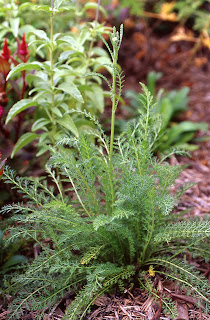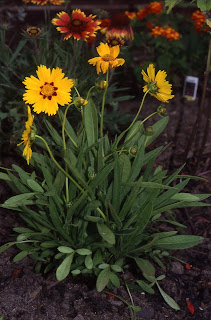Spring Annuals
It’s
spring! With spring the weather warms, the weeds start growing, and our
fall-winter annuals are looking droopy. The month of April is an
excellent time to start replacing the droopy annuals with fresh spring
color annuals. The month of April is now recognized as National Garden
Month. The organization is to raise awareness to gardening education.
For more information into National Garden Month click here.
For
most gardener’s April is the month to start taking a survey of the
garden. What survived the brutal winter we had? Shall I wait to replace
the fall-winter annuals? The majority of Spring Annuals that are listed
below will last from spring to fall. Are you ready to get your garden
ready for spring and summer? Try some of these spring annuals which will
give you lots of color.
African Marigold, American Marigold - Tagetes erecta: Zones:
2-11. Height: 1-4 feet depending on variety. Spacing: 8-18 inches apart
depending on variety. Light: Full sun. Uses: Attracts butterflies and
hummingbirds, Deer resistant annual, beds edger, containers, vegetable
gardens. Deadhead spent flowers to extend blooming.
Ageratum or Floss Flower - Ageratum houstonianum: Zones: 2-11. Height: 6-12
inches. Spacing: 8-10 inches apart. Light: Full sun to partial shade. Uses: Border fronts, edger, hanging baskets, containers, attracts butterflies.
 |
| Ageratum |
Angelonia – Angelonia angustifolia: Zones:
9-11 (perennial), outside zone 9 treated as an annual. Height: 12-18
inches, some varieties can get 24 inches. Spacing: 9-12 inches apart.
Light: Full sun. Uses: Mass plantings, containers, window boxes, edger,
cut flowers.
Balsam - Impatiens balsamina: Zones: 2-11. Height: 12-18 inches. Spacing: 10-12 inches apart. Light: Partial sun to shade. Uses: Beds, borders, containers.
Caladium – Caladium X hortulanum: Zones: 3-10 (hardy in 9-10). Height: 1-2 feet. Spacing: 9-12 inches apart. Light: Full sun to shade, the lance-leaf varieties will take
full sun. Uses: Mass plantings, edger, borders, containers.
 |
| White Wing Caladium |
Cardinal Flower - Lobelia spp.: Zones: 3-10 (short-lived perennial). Height: 1-3 feet, depending
on variety. Spacing: 10-12 inches apart. Light: Full sun to partial
shade. Uses: Attracts hummingbirds, borders around ponds or water
features, low wet areas in the landscape.
Coleus – Solenostemon scutellarioides: Zones:
2-11 (hardy 10-11). Height: 1-2 feet. Spacing: 10-12 inches apart.
Light: Full sun to shade, the newer cultivars will grow in full sun.
Uses: Pots, containers, window boxes, beds, borders, mass or group
plantings.
Cordyline – Cordyline australis: Zones: 9-11, treated as an annual outside zone 9.
Height: 10-15 feet. Spacing: 4-6 feet apart. Light: Full sun to partial shade. Uses: Patio containers.
 |
Cordyline
|
Crested Cockscomb - Celosia cristata: Zones: 2-11, hardy in 10-11. Height: 8-36
inches, depending on cultivar. Spacing: 8-10 inches apart. Light: Full
sun. Uses: Group or mass plantings, borders, containers, fresh cut or
dried flowers.
Dahlia - Dahlia hortensis cv. Figaro Mix: Zones: 3-10, perennial that is treated as an
annual. Height: 12-24 inches depending on variety. Spacing: 6-18 inches
apart. Light: Full sun to partial shade. Uses: Containers, borders, cut
flower, deer resistant. Deadhead flowers to extend blooming.
Dianthus, Annual Dianthus - Dianthus chinensis: Zones: 4-11. Height: 6-12 inches. Spacing: 6-12 inches apart. Light: Full sun to partial
shade. Uses: Window boxes, beds, borders, edger, containers, deadhead flowers to extend blooming.
 |
Dianthus
|
Dichondra Silver Falls – Dichondra argentea ‘Silver Falls’: Zones:
4-11, a perennial in 10-11. Height: 3-4 inches. Spacing: 12 inches
apart. Light: Full sun. Uses: Hanging baskets, containers, window boxes,
drought tolerant, can trail 2-4 feet.
Dusty Miller – Senecio cineraria: Zones:
3-10. Height: 12-18 inches. Spacing: 8-12 inches apart. Light: Full
sun. Uses: Deer resistant, beds, borders, containers, edger.
Elephant’s Ears, Taro – Colocasia esculenta: Zones:
8-10, treated as an annual outside zone 8. Height: 3-6 feet. Spacing:
3-5 feet. Light: Sun to partial shade. Uses: Water feature for ponds,
streams, waterfalls, tropical look to gardens, containers, specimen or
in groupings.
Euphorbia Diamond Frost® - Euphorbia graminea ‘Inneuphdia’: Zones:
2-11. Height: 12-18 inches. Spacing: 10-12 inches. Light: Full sun to
partial shade. Uses: Components in color bowls, containers, hanging
baskets, beds, borders, deer resistant.
Fan Flower - Scaevola aemula: Zones:
3-11, is a perennial in 9-11. Height: 8-12 inches. Spacing: 10-18
inches apart. Light: Full sun. Uses: Hanging baskets, containers, window
boxes, annual groundcover, combo planters, trailing down retaining
walls.
Feather Cockscomb - Celosia plumose: Zones: 2-11, hardy in 10-11. Height: 12-16
inches, depending on cultivar. Spacing: 10-12 inches apart. Light: Full
sun. Uses: Group or mass plantings, borders, containers, fresh cut or
dried flowers. Deadhead flowers to extend blooming.
Flowering Tobacco - Nicotiana alata: Zones: 2-11, hardy in 10-11. Height: 3-5
feet, depending on cultivar. Spacing: 15-18 inches apart. Light: Full
sun to partial shade. Some cultivars have fragrant evening flowers and
can be planted near outdoor activity areas, butterfly attractant, beds,
borders, containers.
Fountain Grass - Pennisetum spp.: Zones:
5-10. Height: 24-36 inches. Spacing: 18-24 inches apart. Light: Full
sun to partial shade. Uses: Borders, containers, specimen, dried
flowers, winter interest, deer resistant.
Geranium - Pelargonium X hortorum: Zones: 2-11. Height: 1-2 feet. Spacing:
12-24 inches apart. Light: Full sun to partial shade. Uses: Groups or
mass plantings, edger, containers, combo planters, window boxes, hanging
baskets. Deadhead flowers to extend blooming.
Globe Amaranth - Gomphrena globose: Zones: 2-11. Height: 12-24 inches.
Spacing: 8-10 inches apart. Light: Full sun. Uses: Beds, borders,
containers, cut and dried flowers, attracts butterflies.
Heliotrope - Heliotropium spp.: Zones: 2-11. Height: 12-36 inches. Spacing:
12-24 inches apart. Light: Full sun. Uses: Beds, borders, window boxes,
hanging baskets, attracts butterflies and hummingbirds, fragrant
flowers, deadhead flowers to extend blooming, all parts are poisonous.
Impatiens - Impatiens wallerana: Zones: 3-10. Height: 6-24 inches. Spacing:
8-10 inches apart. Light: Partial shade to shade. Uses: Beds, borders,
containers, combo planters, hanging baskets, window boxes.
Ivy Geranium – Pelargonium peltatum: Zones:
3-10. Height: 1-2 feet. Spacing: 1-2 feet apart. Light: Full sun to
partial shade. Uses: Hanging baskets, containers, combo planters, window
boxes. Deadhead flowers to extend blooming. Some varieties are
self-cleaning.
Joseph’s Coat – Alternanthera ficoidea: Zones:
3-10. Height: 6-8 inches. Spacing: 12-24 inches apart. Light: Full sun
to partial shade. Uses: Mass plantings, edger, borders, containers.
Lantana - Lantana camara cv. Miss Huff: Zones: 3-10, outside 7 treated as an annual.
Height: 4-6 feet. Spacing: 4-6 feet apart. Light: Full sun. Uses:
Attracts
butterflies and hummingbirds, containers, mass plantings, seaside gardening.
 |
Lantana
|
Million Bells, Super Bells – Calibrachoa X hybrid: Zones: All. Height: 6-9 inches. Spacing: 10-15 inches apart. Light: Full sun. Uses: Filler or spiller for combo planters, hanging baskets, window boxes, patio planters, attracts butterflies and hummingbirds.
Moss Rose - Portulaca grandiflora: Zones: 2-11. Height: 4-6 inches. Spacing:
6-8 inches apart. Light: Full sun. Uses: Annual groundcover, hanging
baskets, window boxes, edger, combo planters.
Ornamental Pepper – Capsicum annuum: Zones:
All. Height: 12-18 inches. Spacing: 12-18 inches. Light: Full sun.
Uses: Mass plantings, containers, combo planters, borders.
Pentas - Pentas lanceolata: Zones: 9-11, perennial; outside zone 9 treated as an
annual. Height: 2-3 feet, the newer cultivars
are 10 or more inches. Spacing: 2-3 feet apart depending on cultivar.
Light: Full sun. Uses: Attracts Butterflies and hummingbirds, beds,
borders, containers, combo planters.
 |
| Pentas |
Periwinkle, Vinca - Catharanthus roseus: Zones: 2-11. Height: 12-24 inches. Spacing:
8-10 inches apart. Light: Full sun. Uses: Drought and heat tolerant,
beds, borders, containers, hanging baskets, combo planters.
Petunia - Petunia X hybrid: Zones: 2-11. Height: 8-12 inches, the wave series stays shorter at 4-6 inches. Spacing: 12-18 inches. Light: Full sun. Uses: Beds, borders,
annual groundcover with the Wave series, hanging basket, containers, combo planters.
 |
Purple Wave Petunia
|
Purple Queen – Tradescantia pallida: Zones:
Hardy from 8-11, outside zone 8 treated as an annual. Height: 12
inches. Spacing: 12-18 inches apart. Light: Full sun to partial shade.
Uses: Annual groundcover outside zone 8, border, edger, hanging baskets,
retaining walls, containers, combo planters.
Purslane - Portulaca umbraticola: Zones: 2-11. Height: 4-6 inches. Spacing:
10-12 inches apart. Light: Full sun. Uses: Annual groundcover, hanging
baskets, window boxes, edger, combo planters.
Salvia - Salvia splendens: Zones: 2-11. Height: 8-24 inches depending on cultivar. Spacing:
8-10 inches apart. Light: Full sun to partial shade. Uses: Vertical
accent, beds, borders, edger, continers, combo planters, attracts
butterflies and hummingbirds. Deadhead flowers to extend bloom time.
Shrimp Plant - Justicia brandegeana: Zones:
3-10, outside zone 9 treated as an annual. Height: 3-5 feet. Spacing:
24 inches apart. Light: Full sun. Uses: Beds, borders, planters, combo
planters.
Spider Flower - Cleome hasslerana: Zones: 2-11. Height: 3-5 feet. Spacing:
12-18 inches apart. Light: Full sun to partial shade. Uses: Beds,
borders, containers, butterfly attractant, filler between newly planted
shrubs. Deadhead flowers to extend blooming.
Sulphur Cosmos - Cosmos sulphureus: Zones: 2-11. Height: 36-48 inches. Spacing:
12-24 inches apart. Light: Full sun. Uses: Beds, borders, cut flowers,
butterfly and hummingbird attractant, containers. Deadhead flowers to
extend blooming.
Swan River Daisy - Brachycome spp.: Zones: 2-11. Height: 6-12 inches. Spacing:
12-24 inches apart. Light: Full sun. Uses: Beds, borders, containers,
hanging baskets, window boxes. Deadhead flowers to extend blooming.
Sweet Alyssum - Lobularia maritime: Zones: 3-10. Height: 3-8 inches. Spacing:
8-10 inches apart. Light: Full sun. Uses: Borders, edger, rock gardens,
combo planters, hanging baskets, between flagstone pavers, fragrant
flowers.
Sweet Pea - Lathyrus odoratus: Zones: 2-11. Height: 3-8 feet. Spacing:
12-24 inches apart. Light: Full sun. Uses: Bushy or climbing annual with
support will reach 6-8 feet. Without support 2-3 feet. Borders,
containers, hanging baskets, cut flower, fragrant flower.
Sweet Potato – Ipomoea spp.: Zones: 2-11. Height: 3-8 feet. Spacing: 2-3 feet apart. Light:
Full sun. Uses: Beds, borders, combo planters, window boxes, hanging
baskets, annual groundcover, containers.
Trailing Lantana - Lantana montevidensis FZones:
2-11. Height: 18 – 24”. Spacing: 3 – 4’ apart, can spread to 5’. Light:
Full sun to partial shade. Uses: Butterfly attractant, heat and drought
tolerant, hanging baskets, window boxes, combo planters, containers.
Wave Petunia - Petunia X hybrid: Zones:
2-11. Height: 5-22 inches depending on cultivar. Spacing: 18-24 inches
apart depending on cultivar. Light: Full sun to partial shade. Uses:
Hanging baskets, window boxes, combo planters, containers, annual
groundcover, and butterfly attractant. The wave petunia will give lots
of color and no deadheading is required, they are self-cleaning.
Wax Begonia – Begonia X semperflorens – cultorum: Zones: 2-11. Height: 6-12
inches. Spacing: 6-8 inches apart. Light: Full sun to partial shade. Uses: Beds, borders, edger, containers, combo planters, window boxes, hanging baskets.
 |
Wax Begonia
|
Wishbone Flower - Torenia fournieri: Zones: 2-11. Height: 12 inches. Spacing: 6
inches apart. Light: Partial shade to shade. Uses: Borders, hanging
baskets, window boxes, combo planters, shade/woodland gardens.
Zinnia - Zinnia elegans: Zones: 2-11. Height: 1-3 feet. Spacing: 8-12 inches apart.
Light: Full sun. Uses: Attracts butterflies and hummingbirds, borders, beds, cutting garden, containers, and combo planters. Deadhead faded flowers to extend blooming.
 |
Dreamland Pink Zinnia
|
©Cheryl Ann Meola 2015.














